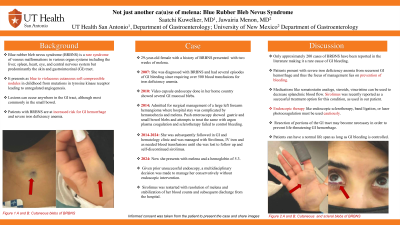Monday Poster Session
Category: GI Bleeding
P2506 - Not Just Another Cause of Melena: Blue Rubber Bleb Nevus Syndrome
Monday, October 28, 2024
10:30 AM - 4:00 PM ET
Location: Exhibit Hall E

Has Audio

Saatchi Kuwelker, MD
University of Texas Health Science Center
San Antonio, TX
Presenting Author(s)
Award: Presidential Poster Award
Saatchi Kuwelker, MD, Jawairia Memon, MD
University of Texas Health Science Center, San Antonio, TX
Introduction: Blue rubber bleb nevus syndrome (BRBNS) is a rare syndrome of venous malformations that arise in various organ systems including the liver, spleen, heart, eye, and central nervous system but predominantly the skin and gastrointestinal (GI) tract. Patients with BRBNS are at increased risk for GI hemorrhage and severe iron deficiency anemia. Here we present a case of BRBNS presenting as melena.
Case Description/Methods: A 29-year-old female with a history of BRBNS presented to the hospital with two weeks of melena. She was diagnosed with BRBNS in 2007 and has had several episodes of GI bleeding since requiring over 500 blood transfusions. She had a video capsule endoscopy at diagnosis that showed several GI mucosal blebs. In 2014 she was hospitalized for surgical management of a large left forearm hemangioma, post-op she developed disseminated intravascular coagulation with bleeding from several sites including hematochezia and melena. She underwent a push enteroscopy then for GI bleeding where gastric and small bowel blebs were found and attempts to treat the same with argon plasma coagulation (APC) and sclerotherapy failed to control bleeding. She was subsequently followed in GI and hematology clinic and was managed with Sirolimus, IV iron and blood transfusions until she was lost to follow up. She presents now with melena and a hemoglobin of 5.3. Given prior unsuccessful endoscopy, a multidisciplinary decision was made to manage her conservatively without endoscopic intervention. Sirolimus was restarted with resolution of melena and stabilization of her blood counts and subsequent discharge from the hospital.
Discussion: Only 200 cases of BRBNS have been reported making it a rare cause of GI bleeding. It presents as violaceous cutaneous compressible nodules in childhood. Lesions can occur anywhere in the GI tract, although most commonly in the small bowel. Patients thus present with severe iron deficiency anemia from recurrent GI hemorrhage and the focus of management lies on prevention of bleeding. Medications like somatostatin analogs, steroids, vincristine can be used to decrease splanchnic blood flow. Sirolimus was recently reported as a successful treatment option for this condition, as used in our patient. Endoscopic therapy like endoscopic sclerotherapy, band ligation, or APC must be used cautiously. Resection of portions of the GI tract may become necessary in order to prevent life-threatening GI hemorrhage. Patients can have a normal life span as long as GI bleeding is controlled.

Disclosures:
Saatchi Kuwelker, MD, Jawairia Memon, MD. P2506 - Not Just Another Cause of Melena: Blue Rubber Bleb Nevus Syndrome, ACG 2024 Annual Scientific Meeting Abstracts. Philadelphia, PA: American College of Gastroenterology.
Saatchi Kuwelker, MD, Jawairia Memon, MD
University of Texas Health Science Center, San Antonio, TX
Introduction: Blue rubber bleb nevus syndrome (BRBNS) is a rare syndrome of venous malformations that arise in various organ systems including the liver, spleen, heart, eye, and central nervous system but predominantly the skin and gastrointestinal (GI) tract. Patients with BRBNS are at increased risk for GI hemorrhage and severe iron deficiency anemia. Here we present a case of BRBNS presenting as melena.
Case Description/Methods: A 29-year-old female with a history of BRBNS presented to the hospital with two weeks of melena. She was diagnosed with BRBNS in 2007 and has had several episodes of GI bleeding since requiring over 500 blood transfusions. She had a video capsule endoscopy at diagnosis that showed several GI mucosal blebs. In 2014 she was hospitalized for surgical management of a large left forearm hemangioma, post-op she developed disseminated intravascular coagulation with bleeding from several sites including hematochezia and melena. She underwent a push enteroscopy then for GI bleeding where gastric and small bowel blebs were found and attempts to treat the same with argon plasma coagulation (APC) and sclerotherapy failed to control bleeding. She was subsequently followed in GI and hematology clinic and was managed with Sirolimus, IV iron and blood transfusions until she was lost to follow up. She presents now with melena and a hemoglobin of 5.3. Given prior unsuccessful endoscopy, a multidisciplinary decision was made to manage her conservatively without endoscopic intervention. Sirolimus was restarted with resolution of melena and stabilization of her blood counts and subsequent discharge from the hospital.
Discussion: Only 200 cases of BRBNS have been reported making it a rare cause of GI bleeding. It presents as violaceous cutaneous compressible nodules in childhood. Lesions can occur anywhere in the GI tract, although most commonly in the small bowel. Patients thus present with severe iron deficiency anemia from recurrent GI hemorrhage and the focus of management lies on prevention of bleeding. Medications like somatostatin analogs, steroids, vincristine can be used to decrease splanchnic blood flow. Sirolimus was recently reported as a successful treatment option for this condition, as used in our patient. Endoscopic therapy like endoscopic sclerotherapy, band ligation, or APC must be used cautiously. Resection of portions of the GI tract may become necessary in order to prevent life-threatening GI hemorrhage. Patients can have a normal life span as long as GI bleeding is controlled.

Figure: Image 1. Blue rubber blebs seen on the skin, hand and eyes of a patient with blue rubber bleb nevus syndrome
Disclosures:
Saatchi Kuwelker indicated no relevant financial relationships.
Jawairia Memon indicated no relevant financial relationships.
Saatchi Kuwelker, MD, Jawairia Memon, MD. P2506 - Not Just Another Cause of Melena: Blue Rubber Bleb Nevus Syndrome, ACG 2024 Annual Scientific Meeting Abstracts. Philadelphia, PA: American College of Gastroenterology.

